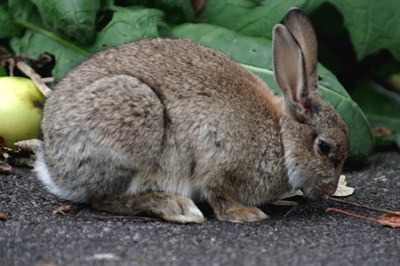Clinical features of RHD

Play video of a young wild rabbit with confirmed RHDV2
RHD has a short incubation period of 1–5 days and death can occur within 12-26 hours. Articles about RHD often describe three clinical courses: peracute, acute or chronic. (Abrantes et al. 2012, OIE 2019) but laboratory and field investigations of RHD often fail to make a distinction between these forms of RHD. It was not possible to make a distinction between these three clinical courses in a naturally occurring outbreak in pet rabbits (Harcourt-Brown et al. 2020 because it was not known when the rabbits were infected and the rabbits were found dead or dying by their owners.
The following ante-mortem signs of RHD are taken from laboratory investigations (Neimanis et al. 2018, Dalton et al. 2019, Le Minor et al. 2020) a case report (Bonvehi et al. 2019) and a naturally occurring outbreak of RHDV2 (Harcourt-Brown et al. 2020).
Clinical features in all rabbits
- Pyrexia (>40 degrees centigrade) is a consistent feature of RHD infection in laboratory investigations although hypothermia can occur just before death. This is a significant clinical sign.
- Anorexia
- Lethargy
Clinical features in some rabbits
- Nervous signs (convulsion, ataxia, paralysis, opisthotonos, paddling).
- Respiratory signs (dyspnoea, frothy and bloody nasal discharge).
- Signs of haemorrhage (haematuria, vaginal haemorrhage, bleeding from the mouth).
- Pallor or cyanosis of mucous membranes.
- Icteric sclera or pinnae
- Darkening of the iris in albino rabbits
- Collapse shortly before death.
Anecdotally, in outbreaks of RHDV2 in pet rabbits, underlying diseases can suddenly flare up (e.g. rhinitis or treponematosis) shortly before death, which complicates the diagnosis. The presence of RHDV2 in these rabbits could easily be missed without post-mortem examination.
Blood sample results
If blood samples are taken, hypoglycaemia, anaemia, raised liver enzymes and bilirubin levels are highly suggestive of RHD, especially in a pyrexic rabbit.
Some differential diagnoses in the live animal
- Liver lobe torsion can cause sudden lethargy, anaemia and collapse. Pyrexia is not a feature.
- Sepsis can cause collapse, hypoglycaemia and pyrexia and intravascular coagulopathy. In some rabbits, a source of infection e.g. a bite wound is obvious.
- Haemabdomen from trauma or a ruptured, torsed liver lobe can cause collapse and anaemia. Affected animals are not pyrexic.
- Heatstroke can cause pyrexia and collapse. The conditions in which the rabbit died are suggestive of heat stroke.
Rabbits that survive RHD
Not all rabbits die after exposure to RHDV. Some are not affected by the virus and others survive infection. It is difficult to differentiate between these cases in the live animal. Clinical signs, such as anorexia and lethargy are non-specific and could be diagnosed as ‘gut stasis’. Chronic liver disease has non-specific signs.
